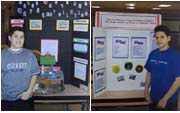Anna L. Klein School in Guttenberg recently held its Science Fair for students in grades five through eight. Of course, it was part of the curriculum. The students received a grade for their efforts.
But many of them found something else while doing their research. They discovered that they could have fun.
Take, for instance, 13-year-old Shabab Naqui, who studied the phenomenon of ESP (extra-sensory perception).
Naqui went on the Internet and found a test that you can give to people to see if they have ESP. So Naqui actually took the time to test 60 people – 20 adults, 20 teenagers and 20 children – and recorded their results, to find if they truly had some form of ESP.
Naqui even tested herself.
“I didn’t have it,” she said.
She also tested the members of her family.
“No one in my family had it either,” she laughed.
Was it hard to find 60 people who were willing to take the test?
“I just asked people and they were happy to take the test to help me,” Naqui said. “They found it to be fun and interesting like I did. I always had an open mind about ESP and wanted to learn more about it.”
And what did she learn?
“I found that teenagers have the most ESP tendencies and adults have the least,” Naqui said.
Naqui also learned the different forms of ESP, like clairvoyance and telekinesis.
“It really was fun and I enjoyed doing it,” Naqui said. “It was interesting.”
Monica Gonzalez, a 13-year-old eighth grader like Naqui, concentrated on electricity, something she has done with each Science Fair project since she was in fifth grade.
“I always liked to work with electricity and I’m fascinated by it,” Gonzalez said. “My projects have always been based on electricity. I just enjoy it.”
This year, Gonzalez focused her project on the differences between hydro and electric power.
For her electric power experiment, she tried to simulate a bolt of lightning by taking a plastic sheet, rubber gloves and a metal fork and rubbing the fork against the plastic sheet to create a spark, which is creating a force field.
But unfortunately, the experiment failed.
But that’s just fine, according to Science Fair coordinator Donna Gryzbowski.
“We told them that it was okay if their hypothesis was not proven to be true,” Gryzbowski said. “We wanted them to go through the process of thinking. We try to encourage the entire process, doing the research, coming up with the hypothesis. It doesn’t have to work all the time. That’s not how science works.”
Incredibly, the ingenious projects designed by Naqui and Gonzalez were not among the award winners at this year’s fair. That shows how extensive and how brilliantly planned the projects were.
“Many were at the high school level,” Gryzbowski said. “I don’t think I was really surprised by their efforts. Our teachers put a lot of time and effort to prepare that we almost expect them to do well. But the kids went far and beyond what we expected.”
Each student is asked to research a topic that they would like to explore, a topic that peaks their interest. Perhaps it’s something that they want to learn more about.
“Most of the topics are selected on their own,” Gryzbowski said. “We only help when they ask advice.”
And the projects are far more extensive than the usual Science Fair lot, like exploding volcanoes and homemade light bulbs.
Seven students earned awards and will display their projects at the Hudson County Science Fair, held at the Liberty Science Center in Jersey City on March 12.
Jose Zapata, a sixth grader, will display his first place presentation about how a Punnett Square predicts possible gene combinations.
Juan Castello, a seventh grader, will show his presentation on Solid Waste and Water Pollution.
Eighth grader Stephanie Taveras will present her popular “Behold the Power of a Nut,” in which Taveras tested several types of nuts and predicted which nuts produced the most oil and which nuts heated the best. The result: the pecan.
Sixth grader Victoria Rodriguez will show off her display “How Different Water Affects Plants.” She determined that lake water makes plants grow the best.
Megan Gryzbowski, a seventh grader, experimented to find the effects of ultraviolet light on bacteria.
Lastny Rodriguez, a seventh grader, wondered whether different colors had any effect on one’s memory.
And eighth grader Ivan Ordonez wondered about the effects of music on the brain. Ordonez determined that people would make the most mistakes while listening to rap music and make the least amount of mistakes while listening to easy-listening romantic tunes.
The award-winning presentations were selected by a group of judges from Memorial and North Bergen high schools, as well as representatives from Unilever Research.
Dr. Richard Penna, the superintendent of schools in Guttenberg, attended his first Science Fair in his new role and came away very impressed.
“I was genuinely impressed,” Penna said. “These kids put a lot of time and effort into their projects, researching to the fullest. They really did a fantastic job.”
For the first time ever, the Science Fair was videotaped and will be broadcast on Cablevision’s public access channel 81 in the future.
“I was amazed with all the reproduction projects and those having to do with space exploration,” Penna said. “It’s definitely not like when we were kids. They exceeded my expectations and I’m very proud.”
“I think the students who are going on to the Hudson County Science Fair truly show the work that was done by all the students,” Gryzbowski said. “I think they’re all winners. We did have some exceptional projects this year.”
